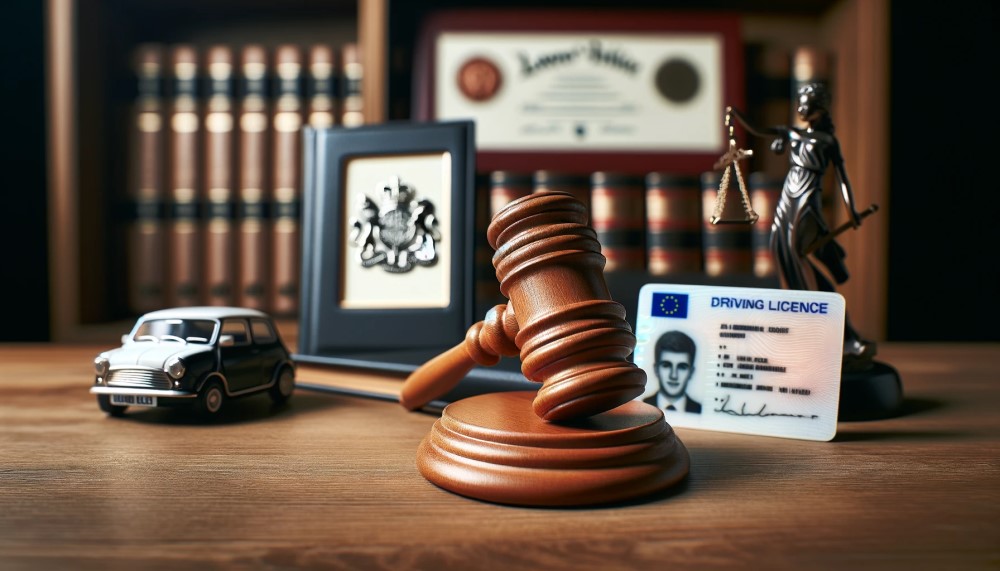What Is the Totting up Procedure, and How Does It Affect My Licence?

What Is the Totting up Procedure, and How Does It Affect My Licence?
The ‘totting up‘ procedure is a significant aspect of traffic law that can have a significant impact on your driving licence. It is crucial to understand this procedure to navigate the potential consequences effectively.
In simple terms, ‘totting up‘ refers to the accumulation of penalty points on your driving licence for multiple driving offenses. These penalties can range from speeding and careless driving to using a mobile phone while driving.
The point system plays a vital role in the ‘totting up‘ procedure. Once you reach a certain threshold of penalty points, your license may be at risk of being suspended. The specific number of points that leads to license suspension can vary depending on the type of driver, such as new drivers facing stricter rules.
Reaching the maximum number of penalty points will result in severe consequences. License suspension, hefty fines, and the requirement to retake a driving test are some potential outcomes.
The implications of the ‘totting up‘ procedure extend beyond legal repercussions. Your insurance premiums are likely to increase, and it may impact your future job prospects, particularly if a driving license is a requirement for your occupation.
While the penalties may seem daunting, it is possible to avoid ‘totting up‘ by driving responsibly and adhering to traffic laws. However, if you find yourself in a situation where you are at risk of accumulating penalty points, seeking legal advice and representation can be beneficial.
Understanding the ‘totting up‘ procedure is crucial to protect your driving privileges and make informed decisions regarding your future on the road.
What is the ‘Totting Up’ Procedure?

The “totting up” procedure, also known as the accumulation of penalty points on a driver’s licence, is a legal process that addresses the consequences of multiple driving offence convictions within a specific timeframe. In this procedure, points are allotted to the driver for each offence committed.
If these points reach or exceed a certain threshold, typically 12 points within a span of 3 years, it can lead to a disqualification from driving. The disqualification period varies based on the number of points accumulated and the driver’s previous driving history.
Having a clear understanding of the “totting up” procedure is paramount for drivers to avoid penalties and ensure the continuity of their driving privileges.
What Does ‘Totting Up’ Mean in Driving Offences?
The term ‘totting up’ in driving offences refers to the accumulation of penalty points on a driver’s licence. This means that every time a driver commits a motoring offence, such as speeding or running a red light, they will receive penalty points.
These penalty points are then added up over a specific period, typically 2 to 3 years. If the total number of penalty points reaches a certain threshold, the driver’s licence may be revoked or suspended. So, what does ‘totting up’ mean in driving offences?
It is a procedure put in place to discourage repeat offenders and ensure that dangerous drivers are taken off the road.
How Does the Totting Up Procedure Work?
The totting up procedure is a system used in driving offences to track the accumulation of penalty points on a driver’s licence.
- When a driver commits a driving offence, they are assigned a certain number of penalty points based on the severity of the offence.
- If a driver reaches a specific threshold of penalty points within a certain time period, they may be subject to the totting up procedure.
- Once a driver reaches the threshold, they will be summoned to court, where their case will be reviewed.
- The court will consider the number of penalty points already on the driver’s licence and any new offences committed.
- If the court decides that the driver has accumulated enough penalty points, they may face a driving ban for a certain period of time.
- The length of the driving ban will depend on the number of penalty points and the driver’s previous driving record.
- After serving the driving ban, the driver’s penalty points will be reset, and they will start with a clean slate.
How Does the Totting Up Procedure Affect My Licence?

The totting up procedure can have a significant impact on your driving licence. It refers to the accumulation of penalty points for multiple driving offenses within a certain time period. If you reach a specified number of points, you could face a disqualification from driving.
Each offense carries different penalty points, and the length of disqualification depends on the number of points accumulated. It is important to be aware of your licence status and drive responsibly to avoid reaching the totting up threshold and potentially losing your licence.
What is the Point System for Driving Offences?
The point system for driving offences is a method used to track and penalize drivers for accumulating violations. Each offence is assigned a certain number of points depending on its severity. When a driver reaches a certain threshold of points within a specific period, it triggers the totting up procedure.
This procedure can result in penalties such as fines, license suspension, or even disqualification.
What Happens if I Reach the Maximum Number of Penalty Points?
Reaching the maximum number of penalty points can have serious consequences for your driving licence. Once you accumulate a certain number of points within a specific timeframe, you may face a driving disqualification.
The length of the disqualification period depends on the severity of the offences and whether you have reached the maximum number of penalty points before. During the disqualification, you will be unable to drive legally, and you may have to retake your driving test.
Having a disqualification on your record can negatively impact your future car insurance premiums and job prospects. It is crucial to drive responsibly and avoid reaching the maximum number of penalty points.
What Are the Consequences of the Totting Up Procedure?
The consequences of the totting up procedure, also known as the accumulation of penalty points through driving offences, can have significant impacts on your driving record and license. These consequences include increased insurance premiums, negative effects on future job prospects, and the potential for licence suspension.
Accumulating penalty points as a result of driving offences can lead to higher insurance costs. This is because insurance providers perceive individuals with a record of penalty points as a higher risk. As a result, premiums are likely to increase.
Furthermore, having a record of multiple offenses can make it challenging to secure certain job positions. This is particularly true for roles that require a clean driving record. Employers may view individuals with a history of offences as unreliable or risky, leading to missed job opportunities.
If you reach the maximum number of penalty points, your license could be suspended. This would result in a loss of driving privileges, limiting your ability to commute and travel independently.
Therefore, it is crucial to be fully aware of the consequences of the totting up procedure and drive responsibly to avoid these negative impacts on your driving record, insurance premiums, job prospects, and license suspension.
Implications of the Totting Up Procedure

The implications of the totting up procedure are significant. The totting up procedure refers to the accumulation of penalty points on a driving licence. When a driver reaches 12 or more points within a three-year period, they face disqualification.
It can result in the loss of a driving licence, impacting a person’s ability to commute, work, and carry out daily tasks. It also means incurring hefty fines, increased insurance premiums, and potential difficulty in obtaining future car insurance.
It is crucial for drivers to understand the implications of the Totting Up Procedure and be vigilant in their driving habits to avoid reaching the threshold of disqualification.
Impact on Insurance Premiums
The totting up procedure can significantly impact insurance premiums. When you accumulate penalty points on your licence through driving offences, insurance companies view you as a higher risk, resulting in higher premiums.
The more penalty points you have, the more your insurance costs will increase. Insurance providers consider drivers with a history of driving offences to be more likely to make claims in the future. It is essential to drive responsibly and avoid accumulating penalty points to prevent the negative impact on your insurance premiums.
Effect on Future Job Prospects
The accumulation of penalty points on a driving license, also known as the totting up procedure, can indeed have an effect on future job prospects. When employers are considering hiring individuals for positions that involve driving responsibilities, they often take into account their driving record.
Here are some potential effects that the totting up procedure can have on future job prospects:
- One effect is the possibility of increased insurance premiums due to the perceived higher risk associated with having penalty points on one’s license.
- The totting up procedure can also impose limitations on job opportunities that require a clean driving record.
- Furthermore, employers may have a negative perception of an individual’s reliability and responsibility if they have accumulated penalty points.
- It is worth noting that certain industries, such as transportation or delivery, may have stricter policies when it comes to penalty points on a driving licence.
To minimise any negative effects on future job prospects, it is crucial to maintain a clean driving record. Taking proactive steps to prevent the accumulation of penalty points can have a positive impact on one’s job prospects.
Is There a Way to Avoid Totting Up?

To avoid the totting up procedure and accumulating penalty points on your license, there are a few strategies you can consider:
1. Good driving behaviour: By consistently following traffic laws and regulations, you can avoid committing driving offences that lead to penalty points.
2. Defensive driving: Being aware of your surroundings, anticipating potential hazards, and practicing safe driving techniques can help you avoid situations that may result in penalty points.
3. Taking driver training or refresher courses: Participating in defensive driving courses or other driver training programs can improve your knowledge and skills, reducing the likelihood of committing offences.
4. Seeking legal advice: If you find yourself at risk of reaching the maximum number of penalty points, consulting with a lawyer who specializes in traffic offences may help you explore legal options or potential defences.
Remember, the best way to avoid totting up is to prioritise safe and responsible driving habits.
Frequently Asked Questions
What is the ‘totting up’ procedure, and how does it affect my licence?
The ‘totting up‘ procedure refers to the accumulation of penalty points on a driving licence for multiple driving offences within a three-year period. If a driver accrues 12 or more penalty points within this time frame, they will be disqualified from driving for a minimum of six months. The disqualification period may be longer if the driver has been disqualified before.
What are the grounds to reduce a ‘totting up’ disqualification?
The courts may exercise discretion for drivers with no previous disqualifications, potentially reducing a six-month ban to three months depending on the nature of the offence and other factors considered in court. The circumstances of the offence and any legal challenge can play a role in presenting grounds for reduction.
How can I prevent a ‘totting up’ ban?
To prevent a ‘totting up‘ ban, drivers should ensure that all points have been incurred within the three-year period and consider the date of the offence. If a driver is already on 9 points and commits another endorseable offense, they will not be able to accept a fixed penalty offer. It is important to be cautious in avoiding any further endorseable driving offences.
Where can I obtain fair insurance quotes after a ‘totting up’ ban?
Drivers who have been disqualified under the ‘totting up‘ system may find it difficult to obtain fair insurance quotes. However, there are specific insurance schemes available for totting up ban drivers. It is advisable to explore these options for obtaining insurance coverage.
What happens if I accept a fixed penalty notice when facing a ‘totting up’ ban?
If a driver facing a ‘totting up‘ ban accepts a fixed penalty notice, it should be noted at the Process Office. Their payment and licence will be returned. However, if the office fails to notice the discrepancy and accepts the payment, the driver’s licence will be returned with additional penalty points. It is essential to be aware of the eligibility criteria when accepting any offers.
How long does a ‘totting up’ ban last?
The length of a ‘totting up‘ ban depends on the driver’s previous disqualifications. If there has been a previous disqualification of at least 56 days within the last three years, the ban can be for 12 months. If there have been multiple disqualifications of at least 56 days within the last three years, the ban can be for two years. The disqualification period starts from the day the court imposes the ban.
Notice: Informational Content Disclaimer
The content provided on this website, including articles, blog posts, and other informational materials, is intended for general informational purposes only. It is not intended as, and should not be considered, legal advice.
Visitors to this website should be aware that the information presented here is not a substitute for seeking legal advice from a qualified solicitor or legal professional. Each individual's legal situation is unique, and the information provided may not be applicable to specific circumstances.
If you require legal advice or have specific legal questions, we encourage you to contact us directly. Our experienced team of solicitors is here to assist you with your legal needs and provide tailored advice to address your concerns.
Please be advised that any communication through this website, including the use of contact forms or email, does not create a solicitor-client relationship. Confidential or time-sensitive information should not be sent through this website. To establish a solicitor-client relationship and discuss your legal matters in detail, please contact us for a consultation.
We strive to provide accurate and up-to-date information, but we make no representations or warranties regarding the accuracy, completeness, or suitability of the information contained on this website. We shall not be liable for any reliance placed on the information provided herein.
Thank you for visiting our website. We look forward to the opportunity to assist you with your legal needs.




